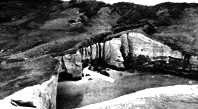
The Tunnel Beach Walkway, one of the most popular scenic walks around Dunedin will be officially opened by the Minister of Lands, Mr Elworthy, on March 16. (1983).
Access to Tunnel Beach has been negotiated by the Lands and Survey Department with the farmer who owns the land the walkway crosses.
The advantage to the farmer of the walkway is that under the Walkways Act he can be compensated if there is damage done and the access can be controlled. For example, the Tunnel Beach Walkway will be closed during lambing.
…
The steps down the tunnel are worn and water seeps through it so concrete steps will be poured before the official opening.
The Tunnel Beach Walkway is a coastal walk, descending a line of seacliffs south of St Clair where the wild Pacific breakers have carved sheer headlands, sea stacks and arches, and the wind has sculptured extraordinary shapes.
From the road end the track descends across green pasture and within a few minutes reaches the clifftops above Tunnel Beach.
The rock underfoot is the soft Caversham sandstone, an extensive thick sediment laid down during the sea’s encroachment of the Dunedin area 20 million years ago. The sandstone was generally overlain by other sediments, but near here lava from the Dunedin volcano flowed over the sandstone itself. This occurred about a dozen million years ago. The soft nature of the almost uniform sandstone makes walking too close to the cliff-edge a dangerous practice, but has also allowed the magnificent carving both by humans and by nature that is in evidence here.
At Tunnel Beach the rock is seen in detail. Careful examination will reveal shell fragments and with luck a fossil such as a brachiopod shell or echinoderm (sea urchin) or even bones of an extinct whale could be found.
At the top of the tunnel and on the promontories, the rock supports a community of salt-resistant species including Austral spleenwort, Selliera sp and Samolus sp. Species that occur further up the slope do not grow here as they cannot cope with the sea water that splashes up during the high seas that can batter this stretch of coastline.
The tunnel was dug in the 1870s by workmen employed by John Cargill, a son of Captain William Cargill, and who farmed the area. It’s reputed to have been a birthday present to his daughter.
The Cargill families found seclusion and shelter on the beach at the foot of the tunnel steps.
The swift flowing current, with is load of sand and erosive potential, heads up the coast just beyond the extremities of this little bay. It must have deterred all but the strongest swimmer from entering the water. At low tide the sandy beach makes an attractive setting for picnics, with the deeply cleft sandstone buttresses towering above. Some are intricately carved, some lie scattered as blocks already tumbled to the beach. Needless to say, common sense dictates where to sit in safety.
Some of the smaller boulders beneath the cliff are derived from the lava floors above, or from Blackhead, a headland of down-thrown volcanic rock being quarried to the south-east.
Vertical rusty streaks of iron-staining make a cross-cross pattern with the near horizontal traces of each successively deposited layer, called “bedding planes”, visible on the cliff faces.
Caves and sea-arches are eroded into the cliffs and an arch at the southern edge of Tunnel Beach, when seen from the walkway above is an excellent example showing the formation of a “stack”.
When the arch has finally eroded and collapsed, the leg on the right will stand free of the mainland just as the stacks off the northern edge of the beach do. Horizontal bedding visible on these stacks suggests that these are still in situ and are not blocks that have fallen from elsewhere.
Amongst a group of trees atop the cliffs, Cargills Castle awaits further depredation by time, vandalism and weather. It was built in 1876 for Edward Cargill, another son of the founder of the Province, Captain William Cargill; and a Mayor of Dunedin 1879-98. Originally called “The Cliffs” it was not long before the Italian-designed building was given its present name by locals. It was one of the first concrete buildings in Otago.
The “castle” was of 21 rooms and cost £14,000 to erect. It was nearly completely destroyed by fire in 1892 and although rebuilt by 1923 – “the biggest white elephant in Dunedin” according to one building contractor – was unfit for habitation.
In more recent years there have been several attempts to instill new life into the building, including an opera venture and plans for a tavern, but all to no avail.
– Dunedin Midweek, Wednesday, Feb 23, 1983.

2 thoughts on “Tunnel Beach Walkway”